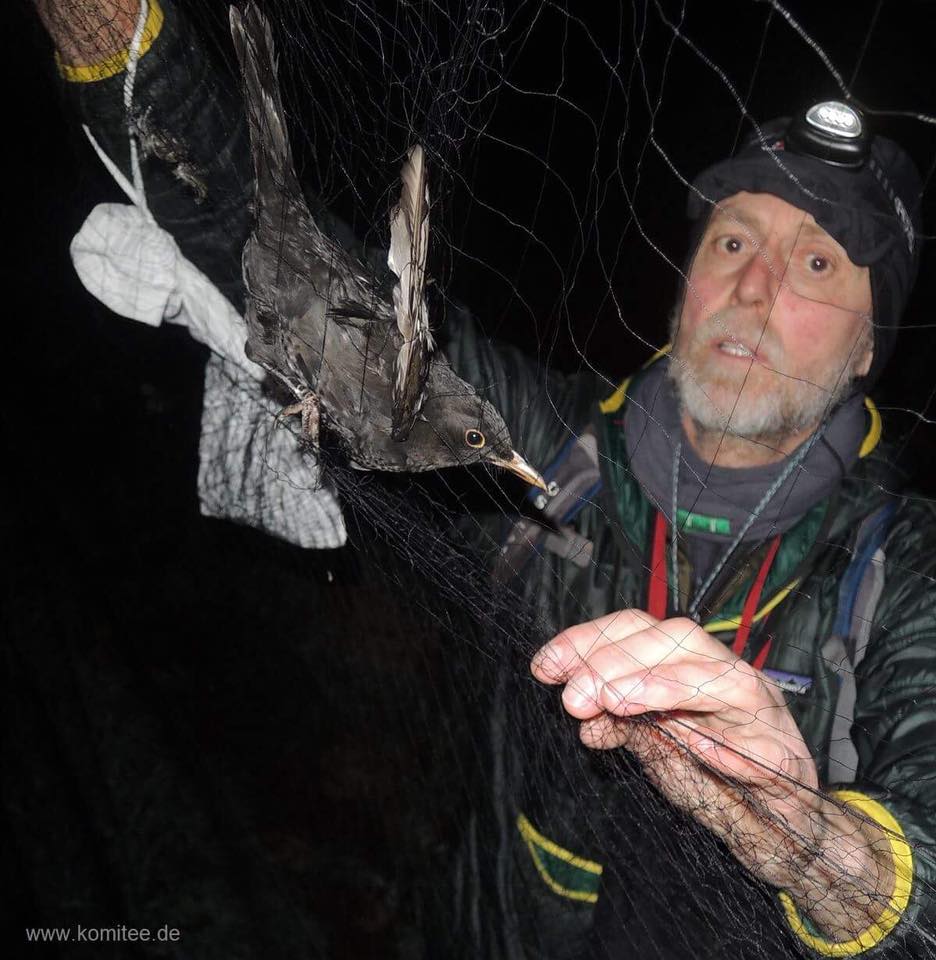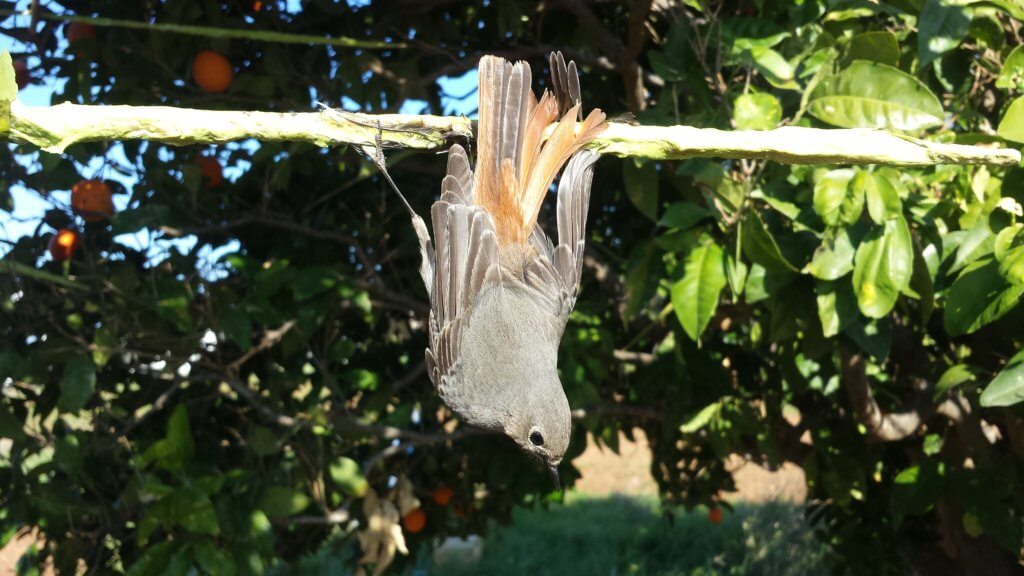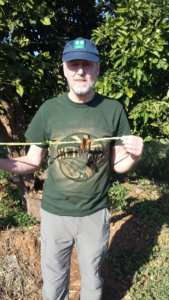
Alister Clunas was born on Orkney. He gained a Masters degree in Resource Management from the University of Edinburgh. His first conservation job was an Assistant Watcher on the Farne Island on £13 per week. Later he worked as a Ranger in East Lothian, a Property Manager in the Yorkshire Dales for the National Trust and at Mar Lodge Estate for the National Trust for Scotland, latterly he worked for Aberdeen Greenspace working with communities to improve greenspaces in the city of Aberdeen.
A keen bird ringer, he rings in NE Scotland, seabirds with the Shiants Auk Ringing Group and has travelled abroad to ring in Estonia and on Vancouver Island. He is a member of the North East Scotland Raptor Study Group.
Given the latest findings of the BirdLife Cyprus surveillance programme show that 6.5km of mist net rides were active during autumn 2017 within the survey area. Based on the data gathered systematically in the field, BirdLife Cyprus estimates that 610,000 birds could have been killed across the whole of Cyprus in autumn 2017. Bird trapping with mist nets for autumn 2017 was 79% lower compared to 2002 levels, when BirdLife Cyprus started its systematic surveillance programme. This is one of the lowest trapping levels with mist nets recorded since the start of the surveillance programme, a very encouraging outcome for the main 2017 trapping season.
I thought I would share my experience of a CABS Winter Camp.
Many of us believe we have principles and feel that we should act on them but taking direct action may not be for everyone.
I had read of the work of CABS and decided to spend two weeks at the CABS Winter Bird Camp in Cyprus. It didn’t seem like a great hardship spending two weeks in the sun. But Cyprus has a darker side.
Hunting and trapping of song birds is a big issue in Cyprus. Blackcaps and other small songbirds are trapped in autumn to create the local delicacy ambelopoulia. In winter most of the hunting and trapping is of Song Thrushes although other species are caught in smaller numbers as a by-catch.

The winter camp consisted of six people and was based in the south-east of Cyprus covering the worst areas for hunting and trapping. In the evening we would be briefed on the areas to be covered and the individual sites we would be checking. We would split into two teams each with a car to check different areas of the island. CABS has collated details of all trapping and shooting incidents on a GPS system and this allows effort to be focussed on trapping “hot spots.” Leaving our accommodation at around eleven pm to “patrol” areas we would return at six, seven or even eight in the morning. It is an exhausting experience involving long hours as well as coping with night shifts. Some of the sites are a long way from the main roads and trappers can be alerted if an approach is made by car. An approach on foot can involve walking up to 15 kilometres in the dark, stopping every now and then to listen for callers. Checking consisted of driving near known sites with a history of trapping, stopping, listening for callers. Trappers play the calls of song thrushes to attract birds and increase their catch. If a caller was heard then one of us would go on foot to check the site for nets.
When nets were found the police would be contacted and directed to the site. There could be up to six mist nets often with birds already caught in the nets. If it was safe to do so (i.e. no trappers nearby) birds would removed from the mist nets by CABS volunteers before the police arrived. The birds were put in cloth bags for safekeeping, taken to safe areas and released.
Unless an area is fenced and an owner can be identified there is little likelihood of a prosecution. If nets are found in open areas they are removed by police and destroyed.
Sometimes we would go out during the day to search for lime sticks. Large numbers of sticks are hidden amongst the bushes on which unsuspecting birds would land and get stuck. It was heart-breaking on one occasion, finding a Black Redstart on a lime stick but we carefully extracted the bird and released it safely.

Song thrushes can be legally shot but callers to attract birds are not allowed. In the winter of 2016-2017 over 3 million Song Thrushes were killed. CABS estimated that half of these were killed illegally using callers. All the hunters that I encountered were using callers so this may be an underestimate.
You could argue that this is a local tradition and should be allowed to continue. What right have we to interfere in others’ traditions albeit that they are illegal. However this is not a small scale “one for the pot” activity. There is money to be made trapping birds and many of the operators act in gangs with organised lookouts to alert them to the activity of CABS and they will try to intimidate the CABS staff and volunteers. During my two week stay we were “tail gated” many times. As many as three occasions in one evening. On another occasion trappers discovered they were being observed by CABS volunteers. They searched for them with spotlights and discharged shotguns to intimidate them. Luckily the police were alerted and came to rescue the volunteers.
There is a clear British connection as much of the illegal activity takes place on the two British Sovereign Base Areas (SBA).
Cyprus is politically complicated and during our stay we worked with three different police forces: Game Wardens and local police in the Republic of Cyprus as well as the SBA police operating in the two British Sovereign Base Areas. Bird trapping is being taken more seriously in the Sovereign Base Areas and the police there are now proactive in targeting trappers.
 What did we achieve?
What did we achieve?
In two weeks we destroyed 66 mist nets and removed 118 lime sticks.
A total of 278 birds of 8 species were released including 253 Song Thrushes (Turdus philomena) , 14 Blackbirds (Turdus merula), 2 Woodpigeon (Columba palumbus), 2 Starling (Sturnus vulgaris), 2 Spectacled Warblers (Sylvia conspicillata), 2 Blackcaps (Sylvia atricapilla ) and 2 Black Redstarts (Phoenicurus ochruros) and a Chaffinch (Fringilla coelebs).
Not a bad result for two weeks.
The dedication and commitment of CABS volunteers, some of whom have been to Cyprus on a number of occasions is amazing and inspiring.
A video diary of the camp compiled by Katie Nethercoat can be seen at:
[registration_form]
Well done Alister and well done CABS. I believe this hands on, boots on the ground approach to conservation work has a real part to play in our efforts to stop illegal hunting. I just wish I had the b…s to do it!
Well done Alister – this sounds like really hard work, physically demanding and emotionally draining on several levels. Like George I wish I had the b…s to do it too – started applying for Malta raptor camp 6 years ago then chickened out!
Thanks. It is only through the commitment and tenacity of CABS staff and volunteers that things are changing for the better.
No point in being labelled an “eco-zealot” and then not behaving like one.
Well done, heroes all of you.
Great to see Birdlife Cyprus tackling the rat poison issue as well. We are slowly contaminating ourselves with the stuff. Even game keepers are saying the stuff is not working especially when the main predator of rats the Polecat is so full of the stuff.
https://www.sciencedirect.com/science/article/pii/S0269749117349035
A superb summary Alister. It really brings alive the scale of the problem and both the dangers and the complications involved in addressing it.
Well done Alister and CABS – you are heros.
Well done, Alister. This is most impressive.